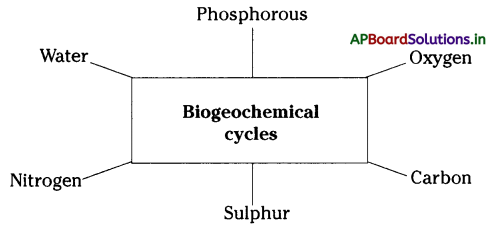Students can go through AP State Board 9th Class Biology Notes Chapter 11 Bio Geo Chemical Cycles to understand and remember the concept easily.
AP State Board Syllabus 9th Class Biology Notes Chapter 11 Bio Geo Chemical Cycles
→ The cycles that involve the flow of nutrients on earth involve the flow of nutrients on earth from the environment to organisms and back through certain pathways are known as biogeochemical cycles.
→ The interaction between the biotic and abiotic components of the biosphere consists of the transfer of matter and energy.
→ Biogeochemical pathways determine the path of transfer of matter on earth.
→ Water is a universal solvent and essential for various reactions to take place within a living cell
→ Nearly 97% of all the water on the earth is in the oceans and so only about 3% is freshwater.
→ Water participates in many biochemical mechanisms, including photosynthesis, digestion, and cellular respiration.
→ Water provides hydrogen and oxygen that form an integral part of basic organic compounds of life.
→ About 78% of nitrogen is present in the atmosphere, but plants and animals can not directly use it
→ A number of bacteria and blue-green algae are known to be able to fix atmospheric nitrogen into compounds in their own body e.g.: Rhizobium and Nitrosomonas.
→ The conversion of nitrates to ammonia by the denitrifying bacteria in the soil is known as nitrification.
→ Nitrogen compounds mainly nitrates or ammonium ions (NH3) are taken up from soils by plants through a process known as assimilation.
→ The production of ammonia (NH3) from nitrates and other nitrogenous compounds is called ammonification.
![]()
→ Solid (NO3) is converted back to gaseous nitrogen (N2) by a process called I denitrification.
→ Carbon dioxide or CO2 makes up about 0.04% by volume of air.
→ Fixing of carbon in biological form takes place within plants and other organisms known as producers – in a process called photosynthesis.
→ Some gases present in the atmosphere such as carbon dioxide, carbon monoxide, methane, and water vapor trap heat from radiating back to space. This is known as the greenhouse effect
→ Excessive amounts of CO2 and other greenhouse gases trap more amount of heat resulting in global warming.
→ Oxygen is found in the elemental form in the atmosphere to the extent of nearly 21 %.
→ Biological Oxygen Demand (BOD), represents the amount of oxygen needed by aerobic bacteria to decompose the waste.
→ Ozone is concentrated in a layer in the stratosphere, about 15.30 kilometers above the earth’s surface.
→ The ozone layer absorbs ultraviolet radiation from the sun, preventing it from reaching the planet’s surface.
→ Oxygen is also an essential component of most biological molecules like carbohydrates, proteins, nucleic acids, and fats.
→ The Montreal agreement in 1987 was to control and phase out the production and supply of ozone-depleting chemicals specifically chlorofluorocarbons (CFCs).
→ Water cycle or Hydrological cycle: It ¡s a process of constantly recycling water.
→ Nitro gen cycle: In this cycle nitrogen is converted from its inert atmospheric molecular form (N2) into a form that is useful in biological processes.
![]()
→ Nitrogen fixation: It is the conversion of atmospheric nitrogen gas into ammonium and nitrates.
→ Nitrification: It is the conversion of nitrates into ammonia by the denitrifying bacteria in the soil.
→ Assimilation: It is the intake of nitrogen compounds mainly as nitrates or ammonium ions (NH) by plants.
→ Ammonification: It is the production of ammonia from nitrates and other nitro generous compounds.
→ Denitrification: It is the conversion of solid nitrate (NO3) to gaseous nitrogen (N2)from animal and plant cells.
→ Carbon cycle: It is the movement of carbon from one component to other components of the ecosystem which ¡s including both living organisms and the abiotic environment.
→ Greenhouse effect: Gases present in the atmosphere such as carbon dioxide, carbon monoxide, methane, and water trap heat from radiating back to space.
→ Global warming: Increase in temperatures of the earth due to the release of more amount of carbon dioxide and other greenhouse gases.
→ Oxygen cycle: Oxygen from the atmosphere is used up mainly by the processes, combustion, respiration and in the formation of oxides of elements like nitrogen, iron, etc., oxygen returns to the atmosphere through photosynthesis.
→ Precursor: A person or thing that comes before.
→ Condensation: The process of a gas changing to a liquid.
→ Precipitation: A chemical process in which solid material is separated from a liquid.
→ Soot: A black powder that is produced when wood, coal, etc. is burnt.
![]()
→ Ozone Depletion: Ozone is a molecule containing three oxygen atoms. Certain industrial processes and consumer products result in the emission of ozone-depleting substances into the atmosphere.

→ Though we usually think of oxygen as being necessary to live in the process of respiration, It might be of interest to you to learn that some forms of life, especially bacteria, are poisoned by elemental oxygen. In fact, even the process of nitrogen-fixing by bacteria does not take place in the presence of oxygen.
→ Vladimir Vernadsky:
- The founder of biogeochemistry was Russian scientist Vladimir Vernadsky whose 1926 book ‘The biosphere’ in the tradition of Mendeleev, formulated a physics of the earth as a living whole.
- Vernadsky distinguished three spheres, where a sphere was a concept similar to the Rieman concept of a space-phase.
- He observed that each sphere had its own laws of evolution and that the higher spheres modified and dominated the lower.